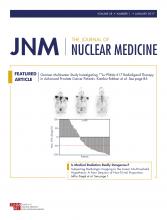TO THE EDITOR: With interest we read the review article by Palestro (1) on radionuclide imaging of musculoskeletal infections. Palestro claims that labeled leukocyte imaging is the radionuclide test of choice for diagnosing prosthetic joint infection. On the basis of our longstanding experience, we strongly disagree with this statement and believe it should be rectified.
First, Palestro failed to describe the numerous disadvantages of labeled leukocyte imaging, which include its complexity, high costs, associated potential hazards due to the direct handling of blood products, and considerable radiation burden (2,3). 18F-FDG PET imaging is practically superior, because it is routinely available in developed countries, provides a completed examination within 1 h after 18F-FDG administration (rather than 24 h for labeled leukocyte imaging), is safe (lack of pathogens in the final product based on existing Food and Drug Administration records), and provides images with significantly higher spatial resolution than that of conventional planar scans (2,3).
Second, evidence-based data indicate that the diagnostic value of 18F-FDG PET is at least equal to that of labeled leukocyte imaging. A systematic review and metaanalysis that was based on 14 studies with a total of 838 lower-extremity prostheses reported 18F-FDG PET to have pooled sensitivity and specificity of 86% and 86%, respectively (95% confidence intervals, 82%–90% and 83%–89%, respectively), for the detection of prosthetic hip or knee joint infection (4). Another more recent prospective study, which included the largest number of lower-extremity prostheses so far (n = 221) and had a subgroup comparison with labeled leukocyte/bone marrow imaging (n = 88), reported 18F-FDG PET to have a sensitivity, specificity, positive predictive value, and negative predictive value of 81.8%, 93.1%, 79.4%, and 94.0%, respectively, for hip prostheses and 94.7%, 88.2%, 69.2%, and 98.4%, respectively, for knee prostheses (5). In patients who underwent both 18F-FDG PET and labeled leukocyte/bone marrow imaging, there was a trend (P = 0.0625) toward a higher sensitivity for 18F-FDG PET in hip prostheses, whereas other comparisons did not show any significant differences between the two imaging modalities (5). Thus, evidence indicates that the diagnostic performance of 18F-FDG PET in detecting infection in painful hip and knee prostheses is sufficiently high for routine clinical application and not inferior to labeled leukocyte imaging. Interestingly, Palestro argues that comparative investigations of 18F-FDG and bone or labeled leukocyte imaging are contradictory. He supports this statement with outdated data that were published by his own research group in 2004 (6). That particular study enrolled only 59 patients with lower-extremity prostheses, and images were acquired with a coincidence PET machine. On the basis of suboptimal data generated with this instrument, the authors claimed that 18F-FDG imaging was less accurate than labeled leukocyte/marrow imaging (6). By now, it is well established that coincidence PET systems provide images of substantially lower quality than today’s standards. Therefore, their claim is totally unjustified. We should mention that recent consensus guidelines do not include leukocyte/bone marrow imaging for detection of infection in painful joints.
In conclusion, 18F-FDG PET, and not labeled leukocyte imaging, should be regarded as the imaging modality of choice for the detection of prosthetic joint infection, as supported by the available evidence and the considerable practical advantages of 18F-FDG PET over conventional methods.
Footnotes
Published online Aug. 11, 2016.
- © 2017 by the Society of Nuclear Medicine and Molecular Imaging.







